Heading out the door? Read this article on the new Outside+ app available now on iOS devices for members! Download the app.
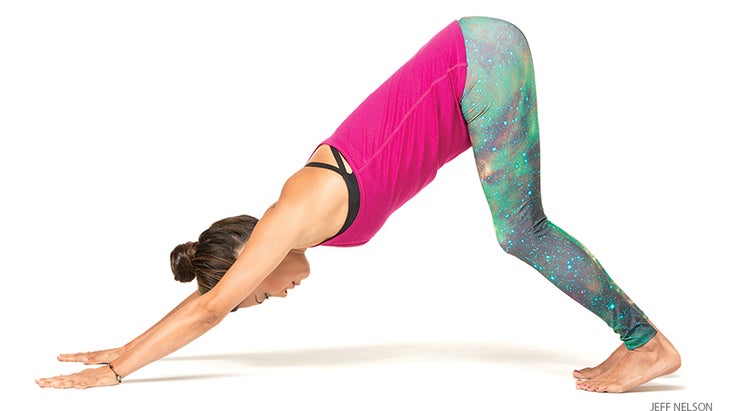
Mula Bandha may be the most befuddling, underinstructed technique in the world of yoga. Here, begin experimenting with how to integrate Mula Bandha into your asana practice.
The bandhas are mechanisms by which a yogi can direct the flow of prana, the universal life-force energy that animates and unites us all. With a few simple adjustments, you can learn to integrate Mula Bandha, one of four bandhas mentioned in the Hatha Yoga Pradipika and the Gheranda Samhita, into your daily asana practice.
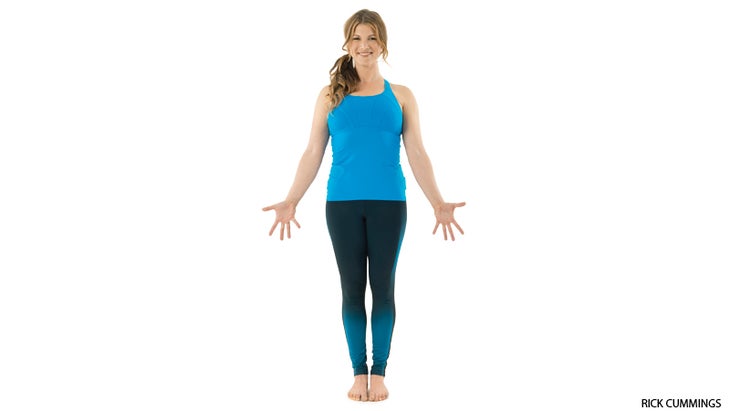
Mula Bandha in Tadasana (Mountain Pose)
In Latin, “pelvis” means basin. In Tadasana, you want this basin to be in a neutral position so that if the basin were filled with a precious liquid, it wouldn’t spill out the front or the back. To find this neutral position, explore the potential placement of the pelvis. Stand upright with your feet together and your arms by your sides. As you inhale, draw the hips and buttocks slightly backward and increase the curvature in the lumbar spine. This is an anterior tilt. Then, exhale and bring the hips and buttocks forward, flattening the lumbar spine and pulling the pelvis into a posterior tilt.
Do this several times, and begin to notice that when the pelvis is in the anterior position, the muscles in the lower back tighten and the inner groins shorten. When it is in the posterior tilt, the buttocks clench and, again, the groins shorten.
To find neutral, stand with your pelvis anteriorly tilted, then lightly lift first the pubic bone and then the pelvic floor as you lengthen the groins—this is Mula Bandha. To find it from the posterior position, draw your hips slightly back until the buttocks relax and the lumbar spine regains its natural curve. As you do this, lift the pelvic floor and lengthen the waist and groins—again, this is Mula Bandha.
When your pelvis is neutral and you find Mula Bandha in Tadasana, you’ll feel a sense of stability without gripping.
See alsoA Woman’s Guide to Mula Bandha
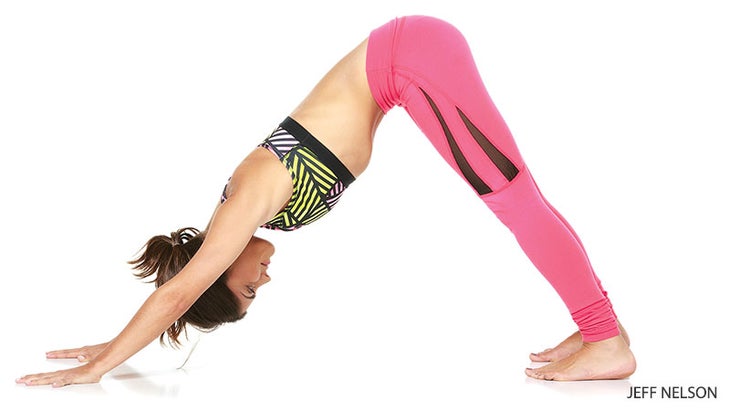
Mula Bandha in Adho Mukha Svanasana variations (Prana Dog and Apana Dog)
Downward-Facing Dog is an excellent pose in which to practice Mula Bandha, especially if you explore two different expressions of the pose: Prana Dog, which is linked to the inhalation, and Apana Dog, which is linked to the exhalation.
From Downward Dog, inhale and extend your spine by taking your head and shoulders toward the floor, drawing your hips away from your hands, and lifting and spreading your sitting bones. This is the Prana Dog.
Then exhale and flex your spine by tucking your pelvis, slightly rounding your shoulders, drawing your ribs up, and looking toward your navel. Now you’re in Apana Dog. Notice that at the end of the exhalation, the pelvic floor naturally draws upward—this is Mula Bandha.
With the next inhalation, create Prana Dog by extending your spine from your tailbone, but don’t allow your ribs to sink too far toward your thighs. Keep lengthening and lightly lifting the area between the coccyx and the pubic bone, between the pubic bone and the navel, and between the navel and the lower ribs. As you exhale, return to the Apana Dog flexion position of the spine, and again focus on how the pelvic floor lifts.
Here’s why: In Prana Dog it is more difficult to access the lift of the pelvic floor, whereas that lift happens naturally at the end of the exhalation in Apana Dog. With the subsequent inhalation, there is a natural tendency to release the pelvic floor and allow the rib cage to drop toward the thighs.
However, it is possible to retain the lift of the pelvic floor with the inhalation if it is accompanied by a light lift of the pubic bone, navel, and lower ribs. This action brings length and leanness to the waist so that the ribs and thighs are drawn slightly away from each other. This leads you into a hybrid pose, which contains both extension and flexion and creates a neutral pelvis, making it possible to engage Mula Bandha during both the inhalation and the exhalation.

Mula Bandha in Virabhadrasana II (Warrior Pose II)
Virabhadrasana II, when done well, is a classic illustration of Mula Bandha in action. But all too often the pelvis listlessly drops into an anterior tilt, the front thigh turns in, and the belly becomes slack. From here, the buttocks go back and the lower ribs jut forward. The knees buckle inward, bringing too much weight to the inner edges of the feet.
To help remedy this, find Mula Bandha in Virabhadrasana II by lifting the pelvic floor, the pubic bone, and the sternum. Bring your pelvis into a more neutral alignment by moving your buttocks forward, so that they’re underneath your shoulders as you draw the lower ribs back. Next, move the sitting bones toward each other. This facilitates the widening of the front of the pelvis and helps draw the thighs and knees away from each other. Bring weight onto the outer edges of the feet and lift the arches.
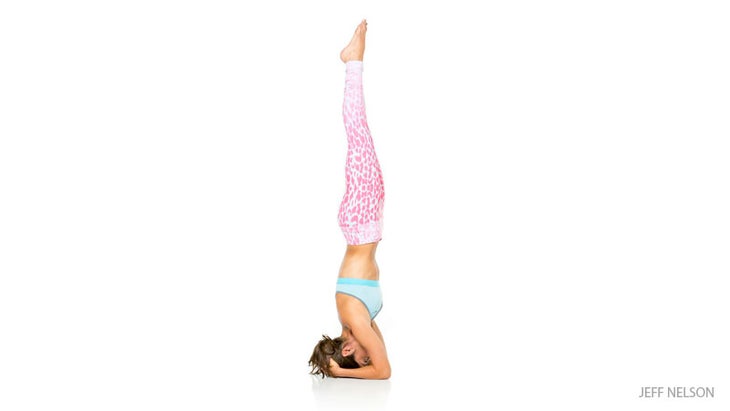
Mula Bandha in Sirsasana (Headstand)
In Headstand, just as in Virabhadrasana II, you’ll often see the pelvis dropped into an anterior position with the ribs jutting forward and the buttocks sticking out. This causes the lower back to compress, and it creates a sense of disconnection between the torso and legs. Applying Mula Bandha can realign the pelvis and provide a link that integrates it with the torso.
When you’re in an inverted position, Mula Bandha is often more natural and easier to find because gravity is already drawing the pelvic floor in the right direction. So, as the pelvic floor lifts, extend the front of the body by reaching strongly upward through the legs and feet and lengthening the groins and waist. To bring the bottom over the shoulders, lengthen the hip flexors, draw the sitting bones together, and draw the tailbone toward the pubic bone—this is Mula Bandha.
With Mula Bandha engaged, draw your inhalation up to the navel, sternum, throat, eyebrow center, and finally to the crown of the head, all the while lengthening the central axis of the body toward the ground. Follow the exhalation through the central axis and all the way back to the mula, or root of the spine.
See alsoMula Bandha: Your Ticket To Infinity and Beyond!
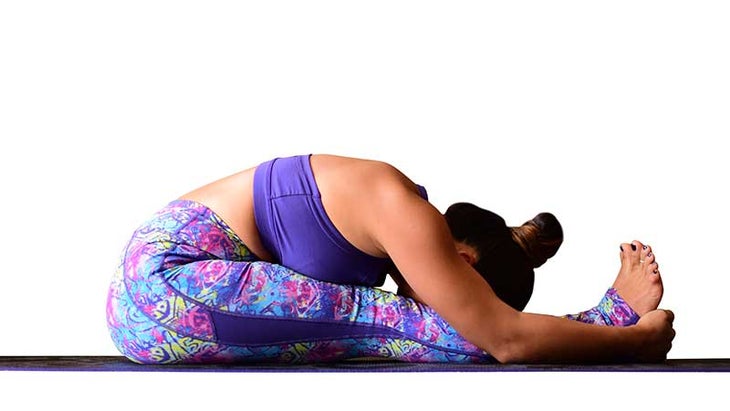
Mula Bandha Paschimottanasana (Seated Forward Fold)
Begin in Dandasana (Staff Pose), an excellent pose to feel the diamond shape of the pelvic floor, which is bordered by the pubic bone in the front, the coccyx in the back, and the sitting bones on the sides. Bring your weight forward on your sitting bones so that they get heavy and the lumbar spine comes into its natural curvature. As you press down into your sitting bones, lift your pelvic floor and draw your pubic bone up. Then lengthen your waist, lift your sternum, draw your shoulders back and down, and drop your chin toward your chest. Let the legs roll inward until the inner ankles touch.
Reach forward and grab your toes. Straighten your arms and extend your spine as you inhale; bend forward on an exhalation. Focus on drawing the sitting bones toward each other while pressing them down, and then lift the pelvic floor. This approach to Paschimottanasana naturally engages Mula Bandha. The effect will be less strain around the sitting bones where the hamstrings originate and less sensation of overstretching in the lower back.

Mula Bandha In a Bind
Some teachers feel that Mula Bandha is overused in American yoga. “In our overdrive culture, there’s already too much tension on the pelvic floor due to overwork, sexual frustration, feelings of failure, disappointment, and the onslaught of images across the media,” says Tias Little. “We overemphasize Mula Bandha, in part because it’s familiar to us.” Ana Forrest purposely downplays Mula Bandha for similar reasons. “When I was in India, I had a realization about Mula Bandha,” she says. “I got sick from the food there, and I began to understand its purpose in a country plagued with dysentery. In America, where we’re plagued with constipation, I don’t think going around contracting the anus is a wise thing.”
For the already tense, stressed, and depressed, the unskillful use of Mula Bandha can have a negative impact. So how do you know if it’s working against—rather than for—you? “The first instruction is always to trust your inner knowing,” says Joan Harrigan, a brahmacharini (monastic) in the Shankaracharya tradition of Advaita Vedanta who’s also a practicing psychotherapist. “With proper engagement of the bandha, there should be a sense of intensified vitality and greater awareness. If it doesn’t feel right, don’t do it!”
See alsoWork Your Core in Any Pose